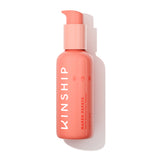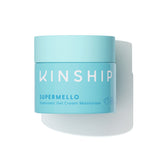Glycolic acid and salicylic acids are among the most effective skincare acids for addressing a range of various skin concerns.
Each acid is effective for addressing issues like acne breakouts or anti-aging skincare treatments.
While both acids work by exfoliating the skin, they target different skin concerns and function in different ways.
In this article, we’ll explore the important differences between glycolic acid and salicylic acid to help you choose the best one for your skin.
Recommended Products
What is Glycolic Acid?
Glycolic acid, a type of alpha hydroxy acid (AHA), is derived from sugar cane. It is the smallest molecule of all the AHAs, which allows it to penetrate deeply into the skin.
Glycolic acid works by dissolving the bonds between dead cells on the skin. This helps it effectively exfoliate and reveal a smoother complexion with brighter skin underneath.
In addition to exfoliation, glycolic acid stimulates collagen production. Collagen is a structural protein that gives skin its firmness and elasticity. Stimulating its production helps maintain youthful-looking skin and reduce fine lines and wrinkles.
Glycolic acid is particularly beneficial for those seeking to brighten their complexion or address concerns like uneven skin texture, age spots, or reduce hyperpigmentation.
Its deep penetration makes it great for brightening dry or sensitive skin and promoting radiant skin.

What is Salicylic Acid?
Salicylic acid is an oil-soluble beta hydroxy acid (BHA) that can deeply penetrate pores. This makes it especially effective for oily or acne-prone skin.
By breaking down excess oil and dead cells within the pores, this ingredient helps prevent and treat acne breakouts.
In addition to its exfoliating properties, salicylic acid works as an anti-inflammatory. This makes it a great choice for those with dry or sensitive, acne-prone skin.
It also reduces redness and irritation associated with acne breakouts. Regularly using salicylic acid can control oil production for a clearer, smoother complexion.

Key Differences Between Glycolic Acid and Salicylic Acid
Though both glycolic acid and salicylic acid are effective exfoliants, they work differently. They target different concerns and suit different skin types.
Understanding how they differ will help you choose the right products for your skincare regimen.
Molecular Structure and Skin Penetration
The molecular size of these acids plays a critical role in their function. It determines how well each acid can penetrate pores, impacting its effectiveness.
Glycolic acid, due to its small molecular size, penetrates deeply into the skin’s surface. This allows it to effectively exfoliate and stimulate collagen production.
This makes glycolic acid ideal for improving uneven skin texture and reducing fine lines and wrinkles.
In contrast, salicylic acid works within the skin’s pores, breaking down sebum and clearing out clogs.
This property makes salicylic acid particularly effective for acne-prone skin as it breaks down sebum and clears out clogged pores.
Exfoliation Method
Both acids are commonly used in skincare for exfoliation, but their methods differ.
The way an acid removes dead skin cells can influence how quickly you notice improvements and how well your skin tolerates the product.
Glycolic acid works by loosening the bonds between dead cells on the skin's top layer. This promotes cell turnover and reveals brighter skin underneath.
This method of exfoliation makes glycolic acid effective for reducing fine lines, improving the appearance of fine lines, and treating sun damage.
Conversely, salicylic acid penetrates pores to dissolve excess oil and dead cells.
This makes it highly effective in treating acne and blackheads, as well as preventing future breakouts.
Best Skin Types for Each Acid
For those with dry, dull, or aging skin, glycolic acid is often the better option. It hydrates the skin while improving texture and reducing signs of aging like fine lines and wrinkles.
Salicylic acid, by contrast, is ideal for people with oily, acne-prone, or combination skin. Its ability to reduce oil and unclog pores makes it an excellent choice for various skin concerns like acne breakouts or blackheads.
Benefits for Specific Skin Concerns
Glycolic acid is ideal for reducing dark spots, treating sun damage, and promoting radiant skin. It’s also helpful for improving uneven skin texture by increasing collagen production.
On the other hand you may wonder, is salicylic acid good for skin prone to oil? Yes, as it effectively removes excess oil and clears pores to prevent future breakouts.
Irritation Potential and Sensitivity
Both acids can cause irritation, but the likelihood of this depends on your skin type and how you use them.
Glycolic acid makes irritation more likely for dry or sensitive skin, as its deep penetration may cause redness or stinging.
When adding glycolic acid into your routine, it’s best to start slowly with lower concentrations. (around 5-10%).
Over-exfoliation with salicylic acid can lead to most common side effects like dryness, but it’s generally well-tolerated.
Which One Should You Choose?

Both glycolic acid and salicylic acid have unique benefits. Choosing the right one for your skin will depend on your specific concerns and goals.
Selecting the appropriate acid can significantly improve the effectiveness of your skincare routine and help you achieve your desired results.
For Acne-Prone and Oily Skin
If you have blackheads, frequently clogged pores, or acne-prone skin, salicylic acid is the better choice.
Its oil-soluble nature allows it to penetrate deep into the pores and break down excess oil, making it ideal for acne-prone and oily skin types.
Consistent use of salicylic acid can reduce breakouts and improve the look of acne-prone skin by preventing the formation of new blemishes.
For Aging, Dry, or Dull Skin
Glycolic acid is more suitable for individuals dealing with dry, aging, or dull skin.
Since it stimulates collagen production and promotes cell turnover, this ingredient can reduce fine lines, improve skin texture, and create a more radiant complexion.
Additionally, glycolic acid is effective for concerns like hyperpigmentation and dark spots. This makes it a powerful solution for overall skin rejuvenation.
Can You Use Both Glycolic and Salicylic Acid?
Yes, it is possible to use both glycolic and salicylic acids in your skincare routine, but they should not be used together.
Instead, use these acids on alternating days. This allows you to experience their benefits without risking over-exfoliation or irritation.
Always monitor your skin’s reaction and adjust your routine as needed to prevent excessive dryness or sensitivity.
How to Use Glycolic and Salicylic Acid in Your Skincare Routine

Adding glycolic and salicylic acids to your skincare routine order can bring significant benefits. However, it is important to use them correctly for the best results.
Here’s a step-by-step guide on how to incorporate glycolic acid into your skincare routine.
- Cleanse Your Skin: Begin with a gentle cleanser to remove dirt, oil, and makeup. This will prepare your skin for better absorption of the glycolic acid.
- Apply Glycolic Acid: Choose a product containing glycolic acid, such as a serum, toner, or peel. If using a toner, apply it to a cotton pad and swipe it across your face. For serums, dispense a small amount and gently massage it into the skin.
- Start Slow: Use glycolic acid 2-3 times per week, especially if you are new to the ingredient or have sensitive skin. Gradually increase usage as your skin builds tolerance.
- Moisturize: After applying glycolic acid, use a hydrating moisturizer to prevent dryness and soothe the skin.
- Apply Sunscreen: Glycolic acid can make your skin more sensitive to the sun. To protect against UV damage, apply broad-spectrum sunscreen (SPF 30 or higher) during the day.
If using salicylic acid, here’s a routine you can follow.
-
Cleanse with a Salicylic Acid Cleanser: If you are using a cleanser with salicylic acid, wet your face and gently massage the product into your skin. Focus on areas prone to breakouts, like your T-zone. Rinse with lukewarm water.
-
Use a Salicylic Acid Toner (Optional): After cleansing, you can apply a salicylic acid toner to further treat acne-prone areas. Soak a cotton pad and gently swipe it across your face.
-
Spot Treatment (Optional): If you are using salicylic acid as a spot treatment, apply a small amount directly to blemishes after cleansing and toning. Allow it to dry before applying other products.
-
Daily Use: Salicylic acid can be used daily, especially for those with acne-prone or oily skin. If dryness or irritation occurs, reduce the frequency.
-
Moisturize: As salicylic acid can be drying, always follow up with a moisturizer to keep your skin hydrated.
-
Apply Sunscreen: Salicylic acid also increases sun sensitivity, so apply broad-spectrum sunscreen (SPF 30 or higher) after using it.
By following these steps, you can ensure you are using both acids effectively. This minimizes the risk of irritation and maximizes the benefits for your skin.
Side Effects and Precautions
It is important to take precautions against potential side effects when using powerful exfoliants like glycolic and salicylic acid.
Overuse or improper application of these acids can lead to unwanted reactions.
Because of glycolic acid’s potency, it can sometimes cause irritation. This is particularly likely if you have sensitive skin or are inexperienced with chemical exfoliants.
Conversely, salicylic acid can lead to peeling or flaking, especially if used too often or in high concentrations.
It is best to start with lower concentrations for both acids and gradually increase usage as your skin builds tolerance.
Frequently Asked Questions
Can Glycolic Acid and Salicylic Acid Cause Purging?
Yes, both glycolic acid and salicylic acid can cause purging in the early stages of use.
Purging happens when exfoliation accelerates the turnover of clogged pores, which can lead to breakouts.
However, this is temporary and usually resolves within a few weeks as the skin adjusts to the new routine.
How Often Should You Use Glycolic Acid or Salicylic Acid?
The frequency of use depends on your skin type and tolerance. Always watch for signs of over-exfoliation, such as dryness or irritation.
Glycolic acid can be used 2-3 times per week. Salicylic acid, for those with acne-prone skin, can be used more frequently, even daily.
What Should You Not Mix With Glycolic or Salicylic Acid?
Avoid mixing glycolic or salicylic acids with other potent exfoliants, such as retinol or vitamin C, as this can cause irritation and compromise your skin barrier.
If using both acids in your routine, use them on alternating days to prevent over-exfoliation.
Final Thoughts: Glycolic Acid vs Salicylic Acid
Both glycolic and salicylic acids are highly effective skincare ingredients. Which one you should choose will depend on your individual skin concerns.
Glycolic acid improves skin texture, reduces fine lines, and brightens dull skin. Alternatively, salicylic acid is better suited for treating acne, clogged pores, and excess oil.
Assess your skin needs carefully and consider adding one or both acids to your routine.
With proper use, both acids can significantly enhance the health and appearance of your skin.
If you are unsure which acid is right for you, consult a dermatologist to make the best choice for your skin type.



